In the morning I had to catch an early flight to Sucre. It was fascinating to watch from the plane as the Andes start to elevate and to see what it looks like as they ascend to higher altitudes. The valleys between the hills and lower mountains are filled out with some apparent deposited mud, soil or whatever, and from a plane it seems as if a muddy torrent has passed there, leaving some sediment in its wake. Admittedly, this is probably what did happen in the past and nowadays, in addition to small rivers running through those valleys it is also possible to see cultivated fields in parts of these open terrains, which suggests that things have mostly stabilized. Likewise, it was nice to watch the landscape around Sucre as the plane approached it. One could easily think that the rounded mountain tops that surround the town were but small hills, if Sucre were not at 2790 m above sea level.
After the heat that permeated the lowlands (Santa Cruz is at 416 m a.s.l.), I enjoyed the coolness of Sucre. It does not mean it was cold. Far from it. It was simply agreeably fresh after Santa Cruz and it could also get quite warm during a day, but not unpleasantly so.
Sucre is an exceptionally beautiful town and I loved it. Not only because of its enjoyable temperature and the sky that was phenomenally blue, cloudless, immense and majestic. The centre of the city has luckily survived in a very fine state, there are no crumbling houses, but neither new urban experiments that would in fact completely destroy the place and its appearance. Additional charm of the town is rendered by its white buildings. Some are simpler, some are true palaces, but they are all white. Sucre is known as the city of four names. One of them is the White City of Americas. Namely, there is some regulation under which all buildings in Sucre, apart from some facade elements, for instance, must be painted white once a year. I don’t know what my hometown, Belgrade (literal translation: White City), looked like when the Slavs, as the story goes, saw it for the first time and uttered in admiration “Look! There's a white city!,” but Sucre is really as white as it can be.
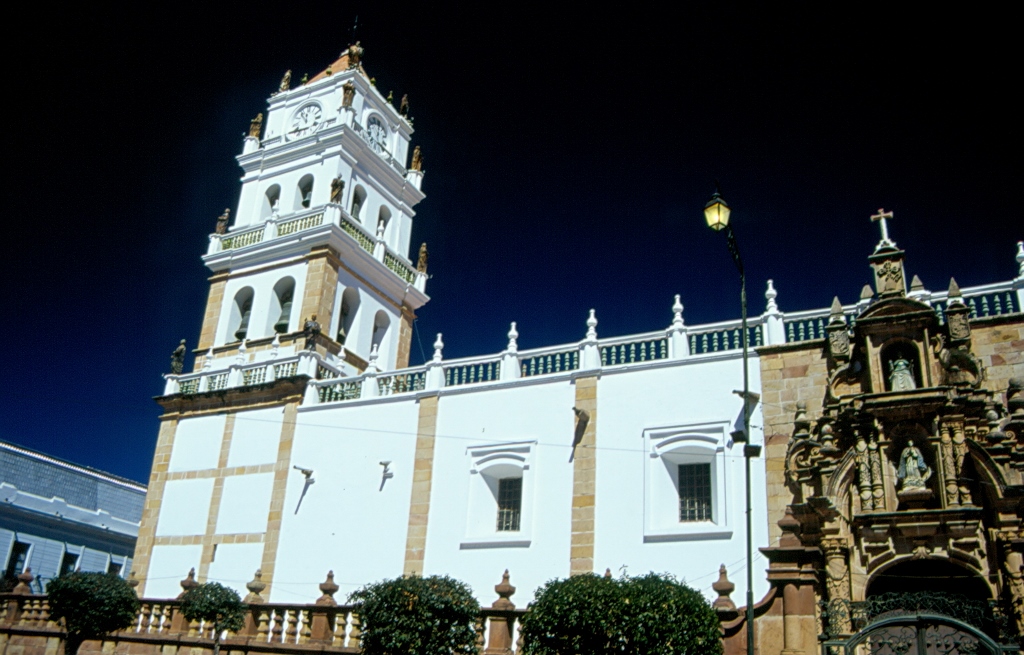 The Cathedral, Sucre
The Cathedral, Sucre
As soon as I checked in at a hotel, I got out and went straight to the Museum of Indigenous Arts. It’s excellent! Not too big, just right. It provides a good ethnographic overview of the local population and I really liked it a lot. This area is generally known for its tapestries and textiles, but predominantly the textiles that have practical use – ponchos, aprons, coca bags, belts, etc.
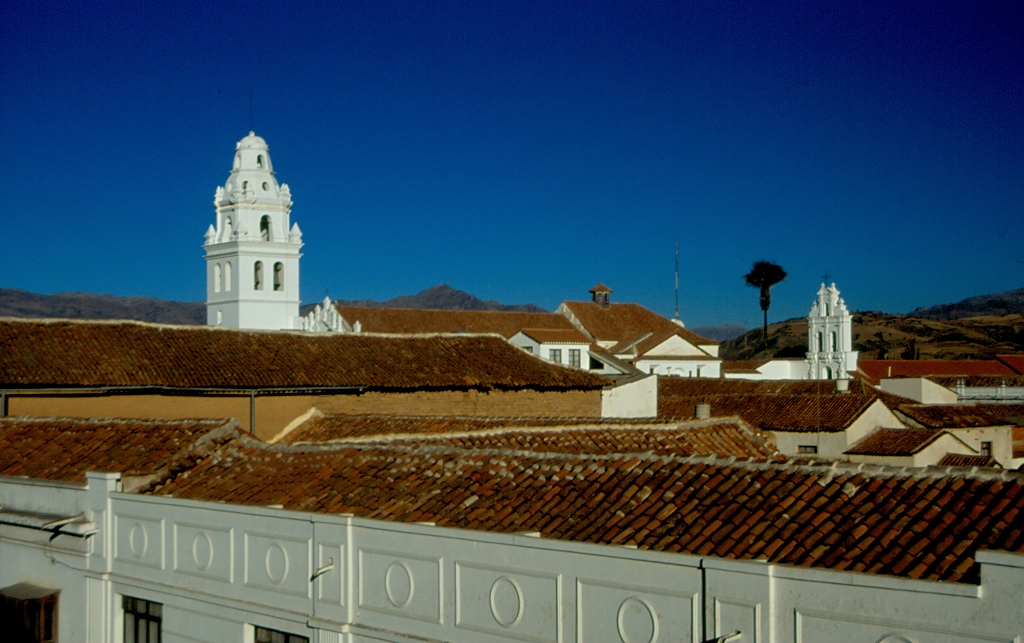 White city’s roofs, Sucre
White city’s roofs, Sucre
Afterwards I went to a market and bought huge quantity of fruit: small bananas, a pineapple, granadillas and cherimoyas. I also bought a medium-size shallow bowl in order to be able to clean the pineapple (I still have the bowl and always feel a tang of memory-infused joy when I use it). I really love fruit, especially when it’s local and when in season. Still, later in the day when I ate the pineapple, I realized it was just far too big for me although I bought the smallest one possible, so I stopped altogether with buying pineapples. Luckily there were all sorts of smaller fruits that were manageable. Talking about fruit, I must mention bananas. It needs to be emphasized that only those bananas that have some brownish spots on the skin are truly ripe. I often buy bananas that are completely yellow or slightly green around the stem, but as a rule I let them rest for a couple of days more until the spots start showing. Bananas needn’t start to rot, but they must be ripe. When I see people peeling and eating bananas the ends of which are still literally green, I get goose bumps and my mouth contracts. I’ve been told by people that they find such bananas tasty, but I think that when one tastes and eats only ripe bananas, one can never go back to the green ones.
Having left the fruit at my hotel room, I went to the main square which is again very pretty, spacious, full of greenery and people, and surrounded by beautiful buildings. The main square is called Plaza 25 de Mayo and it holds a statue of Mariscal Sucre after whom the city got its name. Mariscal Sucre in fact means Marshall Sucre and his proper name was Antonio Jose de Sucre. He was a Venezuelan and the right-hand aid of Simon Bolivar during the war for independence from Spain. He is very popular here and was the second President of Bolivia.
On one side of the square there is the House of Liberty – Casa de la Libertad. Today it holds a museum, but originally it used to be a Jesuit university (the third one in South America). What is important about this building is that it was here that in 1825 the Declaration of Independence was signed and the first Constitution was promulgated, while the country was named after Simon Bolivar who was its first President, albeit for a very short period of time. It is said that Bolivar was against the separation of the territories of the present day Peru and Bolivia, but as he was exceptionally vain he liked the idea of a country being named after him, so that’s how they won him over for the concept. It was also here that Mariscal Sucre was declared the second President of Bolivia.
Talking about the Constitution and the political order of the country, it needs to be said that under the Constitution Sucre is the capital of Bolivia, but nowadays the authority is split between Sucre and La Paz, the latter one playing the role of the de facto capital. Only the judiciary authority has been kept in Sucre and this is where the Supreme Court of Bolivia is situated. By the way, Sucre is included into the UNESCO’s World Heritage List. It is prohibited to construct new buildings and everything is maintained very well, so it is clearly visible how wealthy the city used to be in the past and what it used to look like.
It is precisely from the main square, in front of the Cathedral, that a special truck with benches for tourists placed in the back leaves. The truck drives to a nearby quarry where there is one of the biggest “collections” of dinosaurs’ footprints in the world. This was also my first visit to a quarry and when we got there, we were all first given hard hats. Here is what it is all about. Some twenty years ago, when excavating the stone, the workers stumbled upon a huge rock which was completely covered in the footprints of dinosaurs that used to walk across that surface. The rock stands upright, like a huge canvass in front of a visitor, and different footprints can be easily spotted.
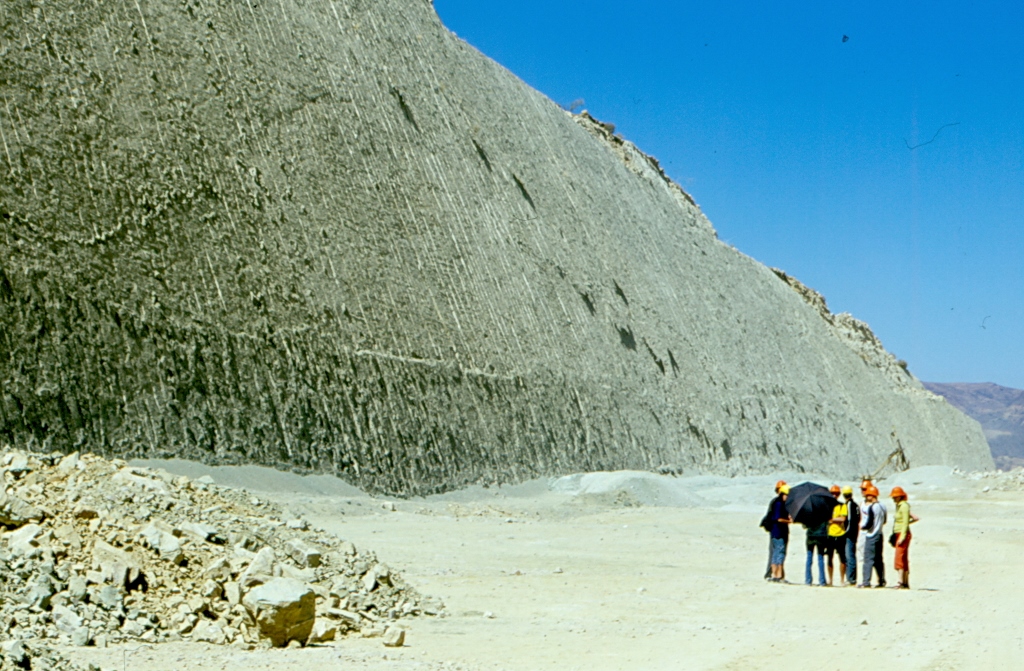 At the quarry, Sucre
At the quarry, Sucre
It goes without saying that dinosaurs did not walk across the vertical surface and this is additionally interesting about the find. The footprints come from the ancient times when this surface used to be horizontal and when dinosaurs could walk there. It is presumed that this used to be some shallow swamp, because it requires mud to end up with this type of trail. In the meantime, the Andes started to rise up and contract, so today we have this enormous upright plate with petrified footprints.
It was also noteworthy to learn some details about the prints. Namely, if the footprints do not have clearly visible claws, it means that they belong to a herbivore. And vice versa – claws are a sure sign that the prints come from a carnivore. Then, in one place there are two parallel trails, but it is impossible that two giant dinosaurs could walk together so closely, as they were rather broad. They actually used to walk in a line, like the present-day elephants, so the prints go in parallel creating a false impression that they went side by side.
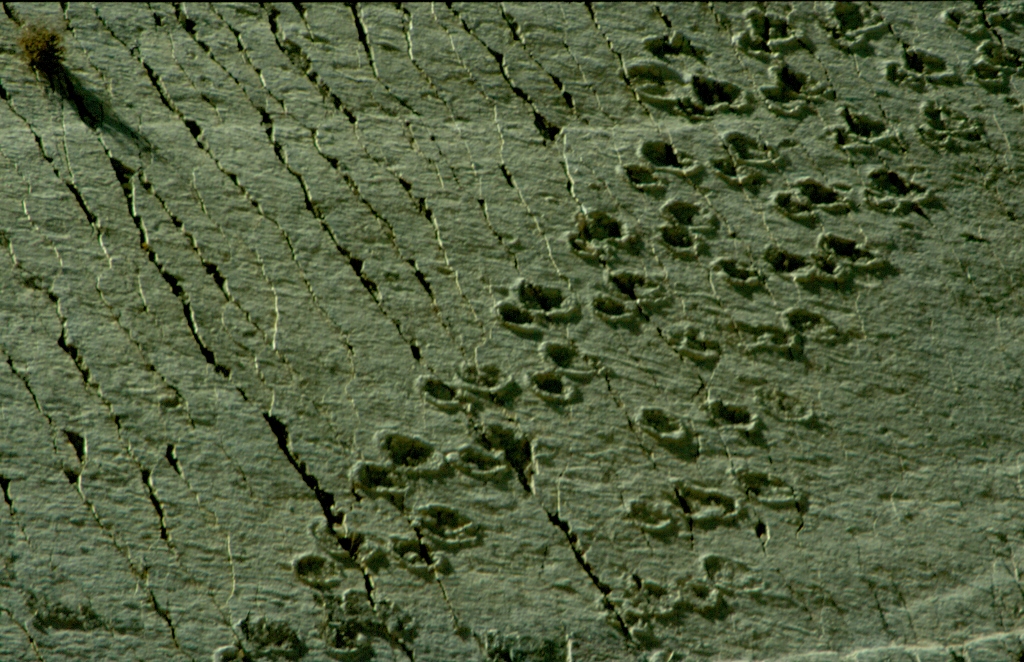 Dinosaurs’ footprints, Sucre
Dinosaurs’ footprints, Sucre
This tour was quite enjoyable, the landscape with the rock and dust was a bit unusual, the sky was indescribably beautiful, but what was very important about it was that there I met a young woman, half German half Bolivian, who had already been to Salar de Uyuni (the next story) and she gave me a couple of great advice. The most important one was to make sure I bought a hot-water bottle, which I did a little later at a pharmacy in Sucre.
I spent the afternoon walking leisurely around the town. There are many churches nowadays and there used to be even more in the past. One of the most interesting ones is the church of Santa Monica with mestizo-style elements used for the facade. The mestizo style means the use of local indigenous elements in arts and crafts. The church of San Francisco is also quite interesting, but primarily because of the signs inside it saying that visitors should not take holy water for magic and casting of spells. Although the Catholic religion is the official faith of practically 100% of the population, the old indigenous roots and traditions obviously continue to be very dominant.
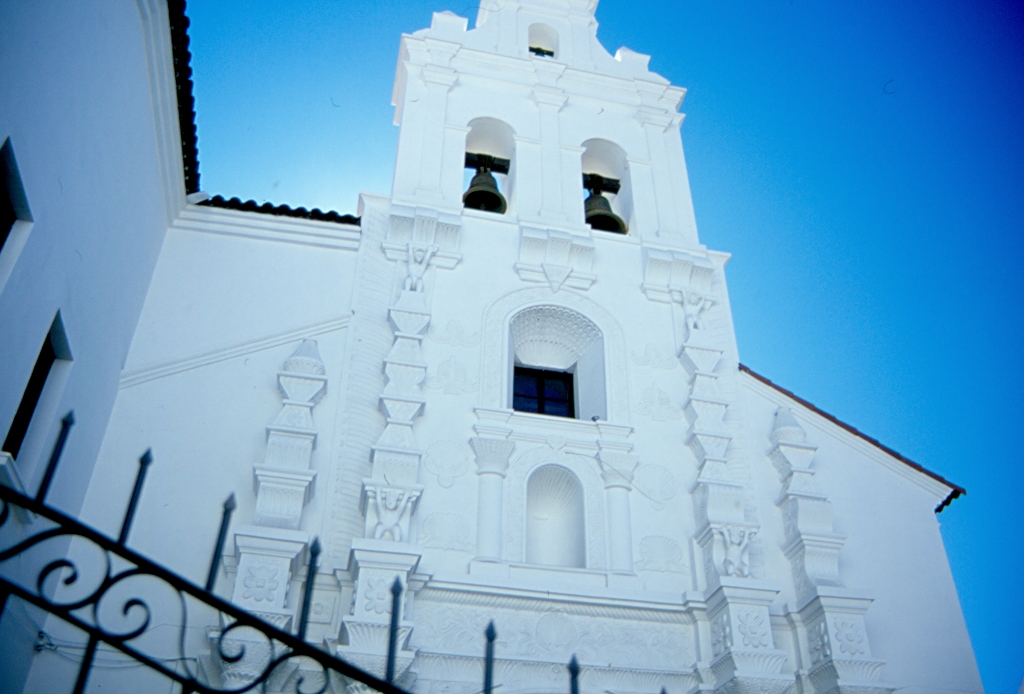 Santa Monica church, Sucre
Santa Monica church, Sucre
Afterwards I also walked to the Faculty of Law which is the building with the biggest courtyard in Sucre. By the way, the University of Sucre is one of the oldest in Americas, founded in 1624, and it remains very popular to this very day.
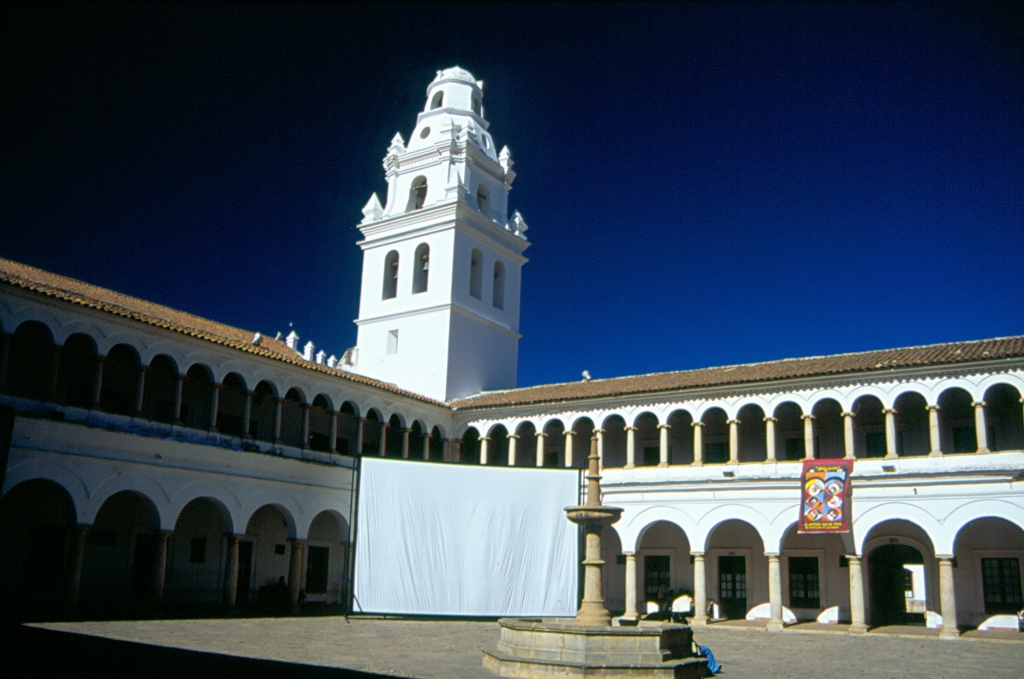 Courtyard of the Faculty of Law, Sucre
Courtyard of the Faculty of Law, Sucre
Following a visit to an internet cafe, I walked uphill to a square in front of the Convent La Recoleta from where there is a beautiful view of the town. It was quite crowded there, since there was a market, some kind of a fair and lots of stands with all sorts of things being up for sale. Among other items, there was chicha – the holy beverage of the Incas, which was in fact a drink obtained from fermented maize. There were also a lot of tables for foosball. How I used to adore it when I was a child and I was even quite good at it! In these things it does help if you have an older brother and his friends; you get to learn a few tricks of trade.
Instead of having chicha, I sat in a cafe full of tourists and ordered a local beer. And this was the place where I enjoyed to the fullest. The view was phenomenal, the temperature was ideal, the sun was setting, the lights of the town were starting to get lit and I listened to great music, a little salsa, a little Louis Armstrong, a little REM, and thus I started to get high with the feeling of happiness that was accumulating in me. I completely enjoyed in everything and I was intensely happy. In such a state of exhilaration I eventually walked down the slope towards my hotel, stopping on my way to book some accommodation in Potosi and Uyuni. It was also wonderful to walk around Sucre at night and to look at the beautifully lit buildings.
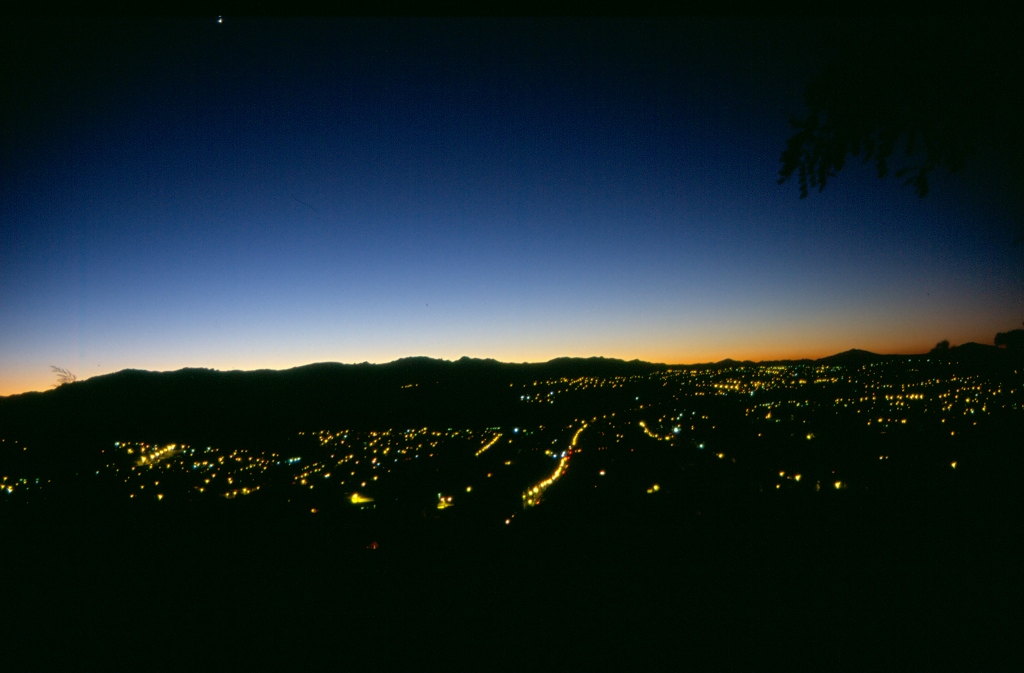 Sunset over Sucre
Sunset over Sucre
Sucre is a truly majestic town. When I was there, I saw and visited in the city and around it everything I was interested in, but to this very day I keep getting a feeling as if I had not been there long enough. To do what? Well, to sit in that cafe and enjoy the sheer existence.